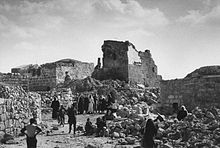Samu Incident
| Operation Shredder | |||||||
|---|---|---|---|---|---|---|---|
| Part of The retribution operations | |||||||
 Samu Incident |
|||||||
|
|||||||
| Belligerents | |||||||
|
|
|
||||||
| Commanders and leaders | |||||||
|
|
|
||||||
| Strength | |||||||
| 400 troops 40 half-tracks 10 tanks |
100 troops 20 convoy vehicles |
||||||
| Casualties and losses | |||||||
| 1 killed 10 wounded 1 fighter jet damaged |
16 killed 54 wounded 15 vehicles destroyed 1 fighter jet shot down |
||||||
| 3 civilians killed 96 civilians wounded |
|||||||
The Samu incident or Battle of Samu was a large cross-border assault on 13 November 1966 by Israeli military on the Jordanian-controlled West Bank village of Samu in response to an al-Fatah land mine attack two days earlier near the West Bank border, which killed 3 Israeli soldiers on a border patrol. It purportedly originated from Jordanian territory. It was the largest Israeli military operation since the 1956 Suez Crisis and is considered to have been a contributing factor to the outbreak of the Six-Day War in 1967. Since 1965 Jordan had an active campaign to curb Fatah sabotage activities. The handling of the incident was widely criticised in Israeli political and military circles, and the United Nations responded with United Nations Security Council Resolution 228.
For three years King Hussein of Jordan had been meeting clandestinely with Israeli Foreign Minister, Golda Meir, and Prime Minister's deputy, Abba Eban, concerning peace and mutually secure borders. On the night of 11 November, an Israeli border patrol vehicle carrying policemen drove over a mine near the Israeli-Jordanian border, killing three and wounding six; the mine was reportedly planted by al-Fatah men. On 12 November, King Hussein sent a letter of condolence to Israeli Prime Minister Levi Eshkol, via the U.S. embassy in Amman. From there it was sent to U.S. ambassador Walworth Barbour at the embassy in Tel-Aviv; instead of forwarding it to the prime minister, he left the letter on his desk – assuming it was not important and there was no rush. According to another version of the story, the letter reached Barbour on the 11th (a Friday), but he delayed passing it on due to the coming Sabbath. Early on the morning of 13 November, King Hussein received an unsolicited message from his Israeli contacts stating that Israel had no intention of attacking Jordan. Early the same day also, the Israeli military mobilized 3000–4000 troops, and sent about 600 of these, with 60 half-tracks and 11 tanks, across the border into the Jordanian-controlled West Bank.
...
Wikipedia
